
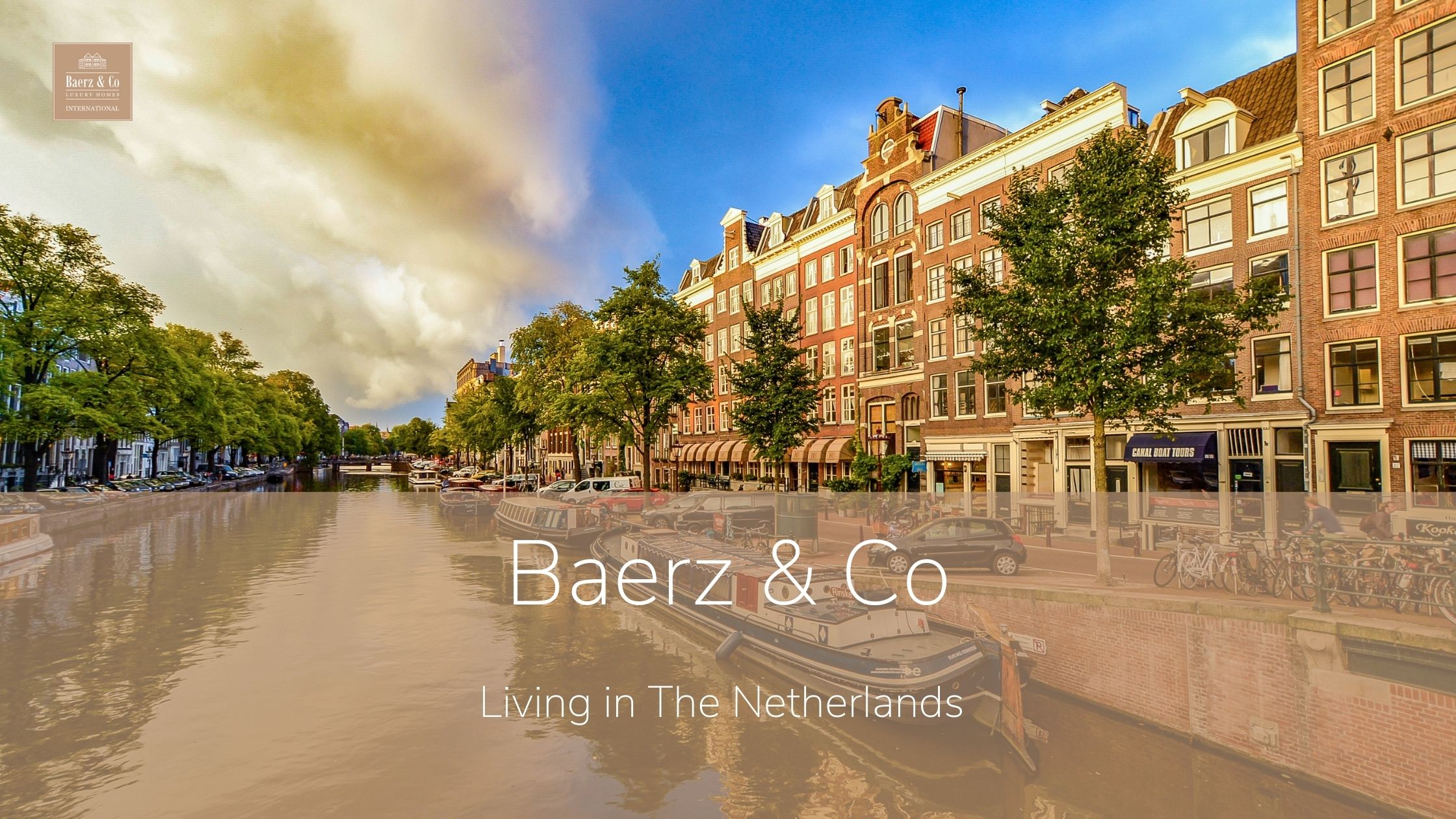
flat country of the Netherlands. Are you more a beach person? No problem, the Netherlands is located along the North Sea. The coastal cities are highly popular among German and English persons of wealth. In this ultimate guide, you’ll learn what living in the Netherlands looks like. Best places to live, houses for sale , or the typical Dutch way of living, these and more topics will be covered!
P.S. here you’ll find our exclusive Dutch homes.
We will help you to find the best places to live in the Netherlands. Each place is unique and has different interesting things to see and experience. How is it like to live there? What can you do and see? What is the cost of living in each of these places? We got your back! After reading this ultimate guide, you know all the highlights of living in the most popular cities.
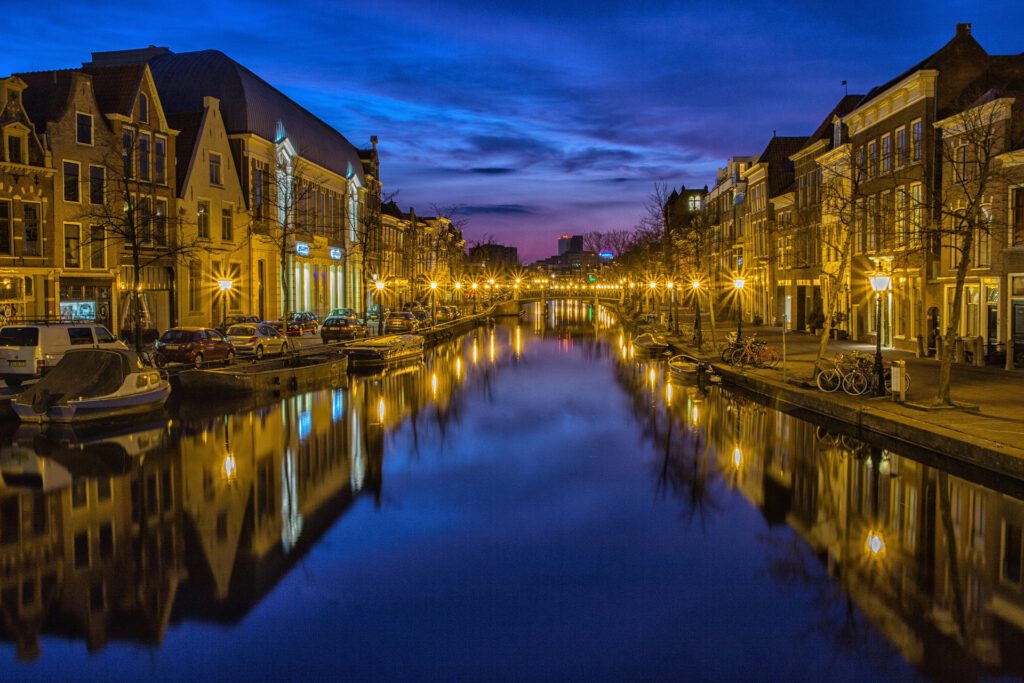
Living in Amsterdam means living in the most expensive city in Europe! But why is it so expensive? Well, this has actually to do with supply and demand. The more people want something, the more expensive it gets. When you live closer to the centre you will pay the most amount of euros. Even though Amsterdam has some bad neighbourhoods, where lots of police is necessary, there are still amazing areas to live in. It’s one of the most popular destinations, as Amsterdam has many great and famous places to go. But before we go over them, let’s dive into some history of this capital first.
What you couldn’t imagine as it’s nowadays a huge, bustling city, is that Amsterdam was once founded as a peaceful fishing village around the 13th century. It was created around the dam of the Amstel river. That’s also where the city name derives from: the Amstel dam. The name Amstelledamme occurs for the first time in 1275. Also, the city is traditionally built on piles: large wooden stakes that are driven into the ground. These are the foundation of all Amsterdam’s buildings because the marshy soil has always been a source of concern for residents and home builders.
Amsterdam is the most successful city in the Netherlands. This is mainly due to the Port of Amsterdam, which is the 2nd largest port in the Netherlands. Once the tiny fishing village was kept from flooding by the dam on the Amstel river, a door for imports and exports had opened. The multinational Port of Amsterdam handles everything from shipping and storing. From resources such as coal, oil, to cocoa beans and paper: millions of tons of cargo pass through this port. The shipping industry started it all for Amsterdam. We also can’t forget to mention the hundreds of cruise ships that come and go every year at the Port of Amsterdam.
Amsterdam is a perfect place in the Netherlands for the shipbuilding industry. Amsterdam opened the doors to worldwide trade. Therefore, it became a dominant financial epicenter and soon it became the world’s first stock exchange. Furthermore, Amsterdam and the Netherlands as a whole is one of the most plugged-in areas in the world. It’s not surprising to know that 98% of Dutch homes have internet access. This makes the Netherlands a top performer in the European Union because it’s higher than the European average, which is 88%.
Also, more businesses like chain craft and bioenergy locate in Amsterdam and contribute to Amsterdam’s goal of being completely coal-free by the year 2030. And in the past, some of the world’s most notable inventions came from the Amsterdam region and the surrounding cities. For example, the first submarine was built by a Dutch inventor called Cornelius van Drebel in the early 17th century.
Did you know that Amsterdam has more canals than Venice in Italy? Yeah, Venice is not the only place where you can step into the well-known gondola and experience the beautiful canals. You can take many canal cruises in Amsterdam to experience the landscape, culture, and history. It’s amazing to watch the scenery glide past. In total, Amsterdam has 165 canals and combined these have a length of 60 miles, and 1281 bridges are connecting these canals. That’s 872 more bridges than the city of Venice. And because the houses are built on stilts, which soon sank into the ground, you will find many crooked houses. The houses lining the canals are also called ‘’dancing houses’’ as they still sway.
There are four main canals in Amsterdam, that were dug in the 17th century during the Dutch Golden Age. These canals form concentric belts around the city, which is known as the ‘Grachtengordel’. Also, there are 1550 monumental buildings alongside these main canals!
The most beautiful canal of Amsterdam, where many Amsterdam locals agree on, is the Brouwersgracht. It has beautifully preserved canal houses, many attractive houseboats, small streets bordering the canal, bridges decorated with flowers and Dutch bikes locked to them (yeah, that’s a thing in Amsterdam) and more. The Brouwersgracht belongs to the most popular residential areas in town, with prices of real estate that have skyrocketed over the past years.
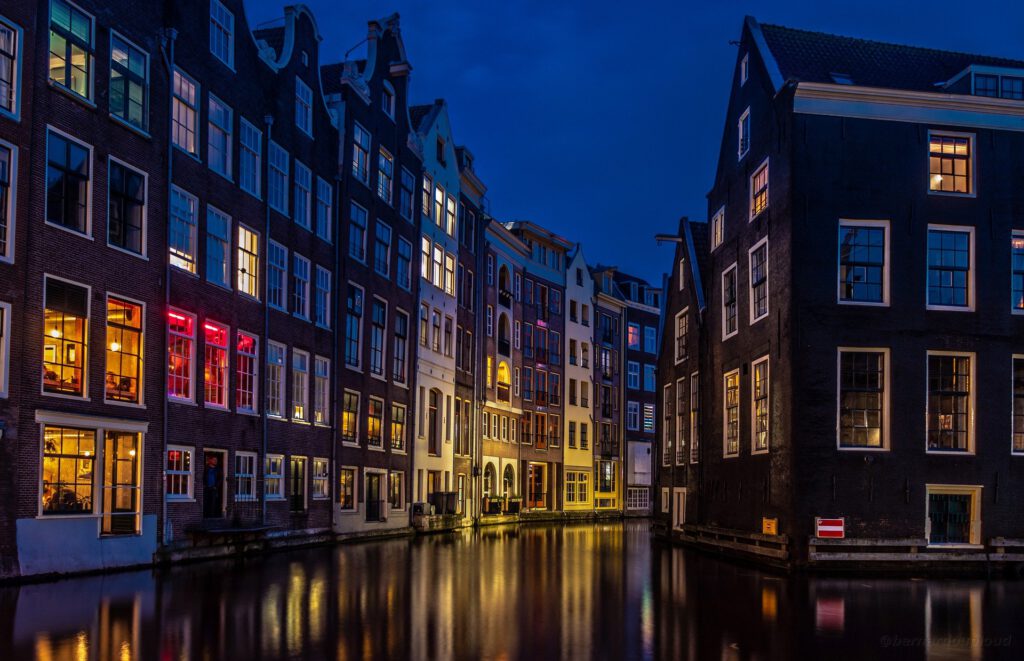
The Prinsengracht is another impressive canal, with a length of more than 3 kilometres. It starts in the northwest at Brouwersgracht and ends in the Amstel river. It took about 50 years to complete the construction of Prinsengracht, which started in 1612. Right at the beginning of the Prinsengracht, you will find fine pieces of canal architecture. There are two Amsterdam icons next to the Prinsengracht: the Westerkerk, and the Anne Frank’s House.
The Westerkerk comes from the 17th century, built in Renaissance style and it has a tower that’s 87 meters high. Anne Frank’s house is a place where once, during WW II, a Jewish teenage girl hid from the Germans. She wrote her famous diary there till she was betrayed and transported to Germany. Here, she died in Bergen-Belsen. Her diary called ‘Het dagboek van Anne Frank’ or ‘The Diary of a Young Girl’ in English is one of the most read and inspirational books about the persecution of Jews.
The Herengracht is one of the main canals in Amsterdam, known for its beautiful and large canal houses. In the 17th century, rich merchants and top-class regents built their impressive houses at the Golden Bend (Gouden Bocht). This bend of the Herengracht got this name because it’s known as the most prestigious part of the Herengracht. Many office owners like to settle here, at least when they can afford antique chandeliers, decorated high ceilings and marble staircases. The Herengracht also has particular areas where the facades of the houses are double the regular size.
Amsterdam is a great city to experience fine dining. One outstanding restaurant to experience this is called the Duchess. Inside this restaurant, you will find glittering chandeliers, a diner that’s served by a romantic glow of candlelight, and menus that change every month. The Duchess is one of the best-kept historic gems. Another example of fine dining in Amsterdam is Graham’s Kitchen, which is a fabulous fine dining restaurant with a casual atmosphere. The ambience is chic and yet relaxed. And if you want to experience the highest-rated fine dining restaurant in Amsterdam, then you should visit De Silveren Spiegel for an amazing culinary experience.
There are some great places to visit and experience in Amsterdam. From museums to the royal palace and a wonderful lookout that offers you beautiful, stunning views across the city. Are you ready? Let’s get you to know the must-visits in Amsterdam!
One must-visit in Amsterdam is the NEMO science museum. Even if you’re not interested in science and technology as much, it’s still a must-visit because here you will discover how fascinating science and technology are. There are five floors crammed full of experiments, exhibitions, workshops and demonstrations, where you will discover how special everyday things are. Little things in life are infinitely the most important, and the world is also moved by the aggregate of the tiny pushes.
This museum is great for both kids and adults, and there are lots of exhibitions that are academically designed to actively stimulate and inspire your mind. Good to know is that the NEMO science museum is also chosen as the most kid-proof museum in the Netherlands by museum inspectors. And this is not surprising, because there are so many things to do and see. That’s why many schools decide to do a school trip there. It’s also helping children to discover that math is not as boring as at school.
Some examples of exhibitions are: ‘Sensational Science’ where you discover the science behind every day phenomena such as light and sound, ‘World of Shapes’ where you discover mathematics in the world around you, ‘Energetica’ where you experience the energy captured from wind, water and the sun. You can even experience ‘Water Power’ and tame the power of water to build a dam. Well, what’s a better place to do this than Amsterdam.
Anyway, the possibilities are endless! When you take the time to appreciate the little things, you may notice they were the big things. The NEMO science highly contributes to this and might bring you an experience you will never forget.
It can be exciting to visit the Johan Cruijff Arena. This is the main stadium of Amsterdam and the home stadium of AFC Ajax, which is a football club in the Netherlands. It has cost about 140 million euros and it’s the largest stadium in the Netherlands. The Johan Cruijff Arena is not only interesting to experience for football lovers. No, because it is also home to the most spectacular concerts and most beautiful business events. It’s very easy to reach the arena both by car and public transport. Everyone is welcome, and inside the arena, you could enjoy different warm and cold drinks, from white wine to hot chocolate. There are also tasty sandwiches that
The Rijksmuseum is the place in Amsterdam where you can find famous and magnificent art from both the Netherlands and other countries. It’s in the top 3 of most visited museums in the Netherlands! It’s easy to access, as there are even busses and boats that drop you off right at the gate and entrance of the Rijksmuseum. It all started in 1800, because of a desire to display the Dutch rarities which the fled regens left behind, as well as portraits of the Royal family or a collection of Italian art. It also has a gigantic and enchanting library, which could give you a feeling like you’re in the Harry Potter movie.
The collection includes famous works of Rembrandt, such as The Nightwatch. The collection has moved many times. One time was during the Second World War when a large selection of art was brought to safety in underground passages in Maastricht. Maastricht is a city located in the south of the Netherlands. Once the war was over, everything was back in the Rijksmuseum again. Nowadays, the Rijksmuseum displays more than 8000 pieces of art! You will find paintings from the 1500s to the 1900s, with a main focus on the Dutch Golden Age which happened in the 17th century. The big renovation where the Rijksmuseum went through had made a huge impact in maintaining the original style of the Rijksmuseum.
Would you like to experience a breathtaking view of Amsterdam? See the historical centre, the unique Dutch polder landscape, Amsterdam’s pulsating port, and famous canals, all at the same time? Or do things where you get an adrenaline rush? Then you should visit the A’dam lookout! It’s located on top of the A’dam tower in the north of Amsterdam. One of the most impressive things to do here is to get into the highest swing of Europe called the ‘over the edge’. Here you will dangle about 100 metres above the ground, where you go back and forth over the edge. It’s very impressive to see Amsterdam below your feet. If this doesn’t give you an adrenaline rush, then I don’t know what will.
Furthermore, you can take a seat in the unique virtual reality rollercoaster through the city, called the Amsterdam VR ride. You put on a set of VR glasses, and then the ride can begin. Something impossible in real life is possible in virtual reality. It is a very unique and exciting way to experience all the highlights of Amsterdam, at a rapid pace! And all whilst the adrenaline rushes through your veins. The A’dam lookout is also a perfect place to learn more about Amsterdam’s history and culture. You can use interactive binoculars to spot iconic buildings and listen to the free audio tour that tells you all the fun facts and highlights. Even the elevator itself in the building is a spectacular experience, thanks to the light, see-through ceiling, and sound effects.
And of course, there’s a wide range of foods and drinks at the Panorama Restaurant and the Sky Bar. You could even go for a full 7-course dinner! And if you want to keep it simple, you could grab a quick coffee, a chocolate cake, or a snack here as well. When you’d like to keep a memory of the A’dam lookout on a free-to-download photo or a paid, printed picture at the exit, you can use the Digital Memory. Here you can balance above the city where the GoPhoto team takes fascinating pictures and videos.
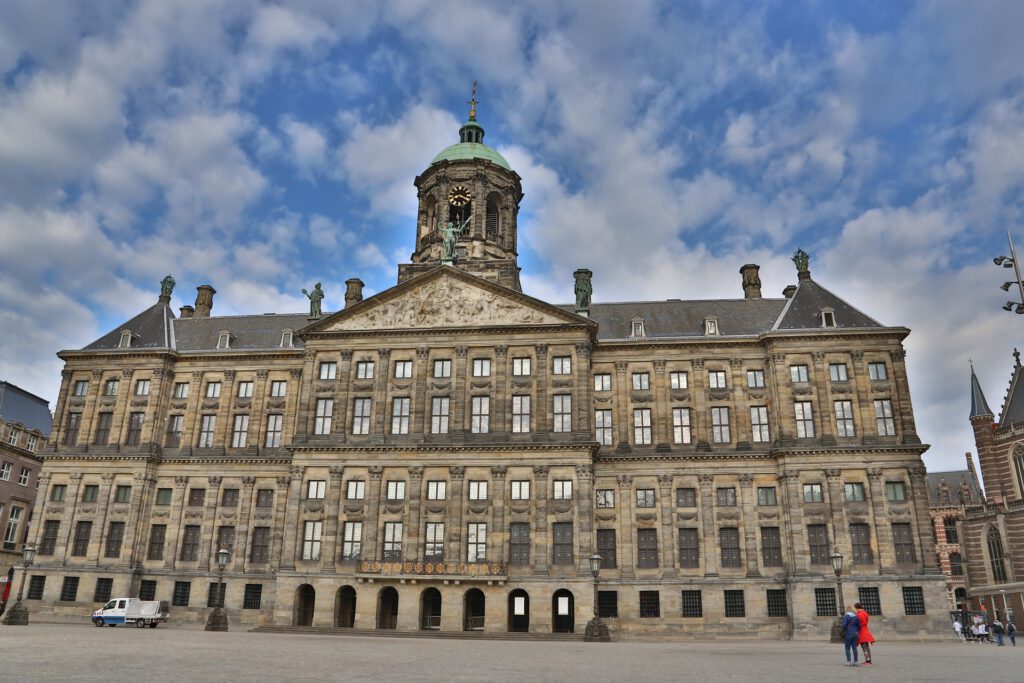
Once, the Royal Palace of Amsterdam was home to King Louis Napoleon, and later to the Dutch Royal House. First, it was built as a city hall during the Dutch Golden Age in the 17th century. You can find the Royal Palace of Amsterdam on the west side of Dam Square in the centre of Amsterdam. It’s also next to the Nieuwe Kerk (new church) and the War Memorial. Nowadays, it’s the official reception palace of King Willem-Alexander. He also uses the Royal Palace is for his speeches. For example, the king holds a speech on the dam, where he later moves to the Royal Palace where he waves to the cameras and people from the balcony with his family.
The Royal Palace Amsterdam is one of the most important monuments in the Netherlands, and it’s open to visitors as much as possible. It’s great to experience the largest most prestigious building from the seventeenth century: the Royal Palace of Amsterdam! When you visit the Royal Palace you have a chance to walk through imposing halls and rooms with paintings. The Royal Palace is where you can follow in the footsteps of loyal guests. The chandeliers, mantel clocks and Empire furniture are reminiscent of the time of King Louis Napoleon in 1808. The palace is often visited by tourists on the dam.
A must-visit restaurant in Amsterdam is called the Sea Palace. This is a floating Chinese restaurant in Amsterdam, with fantastic food combined with wonderful views. The building is made in a typical Chinese style as you will spot Chinese architecture on the outside, and many Chinese decorations on the inside. The staff is friendly, and when you get a seat close to a window, you can have a beautiful view of the canal whilst you eat your excellent Chinese food. The Sea Palace uses fresh ingredients, a good variety on the menu, in a great atmosphere. Sea Palace is highly visited by tourists from the dam.
Would you expect that Amsterdam has one of the most exclusive stores in Europe? Shopping at the most exclusive stores in Amsterdam could be a great addition to your luxury trip. In the luxury shopping district, at the street called the PC Hooftstraat, you will find lots of designer items from across the globe. Even famous brands like Chanel, Jimmy Choo, Prada are located here. Furthermore, dozens of private boutiques are tucked away in Amsterdam’s 9 small streets. This whole street network is intersected by canals. So, if you’re in for seeing some high-end fashion, vintage stores, expensive jewellery or precious antiques: the PC Hooftstraat in Amsterdam is the place to go.
If there’s a hotel in Amsterdam that’s worth mentioning, it would be the Grand Hotel Amrâth. This hotel is a luxurious 5-star hotel that’s located in the ‘Scheepvaarthuis’, which is a 107-year-old monument in the Amsterdam School style. They restored the hotel so beautifully! You can find this hotel at the Prins Hendrikkade in the city centre, which is only 1100 metres away from Dam Square and 500 metres away from the central station. Grand Hotel Amrâth offers 205 rooms and suites, and a free entrance to the Spa & Wellness centre. Furthermore, you will find lots of facilities to ensure you get the best experience during your stay. And not to forget the views on the canals and the streets. If you decide to stay here, you will have been to a hotel you’ll never forget.
Now you know a lot more about the capital, let’s get you to know how expensive it is to buy or rent a place in Amsterdam. It was the most expensive city to live in Europe, remember? The closer you live to the centre of Amsterdam, the more expensive it gets. The difference can be hundreds of euros for renting in the city centre compared to outside the city centre. The price range of renting in Amsterdam varies from 400-1200 euros for a room, to 2000-5000 euros for a 2-3 bedroom apartment or house. And the average home in Amsterdam costs above 500.000 euros.
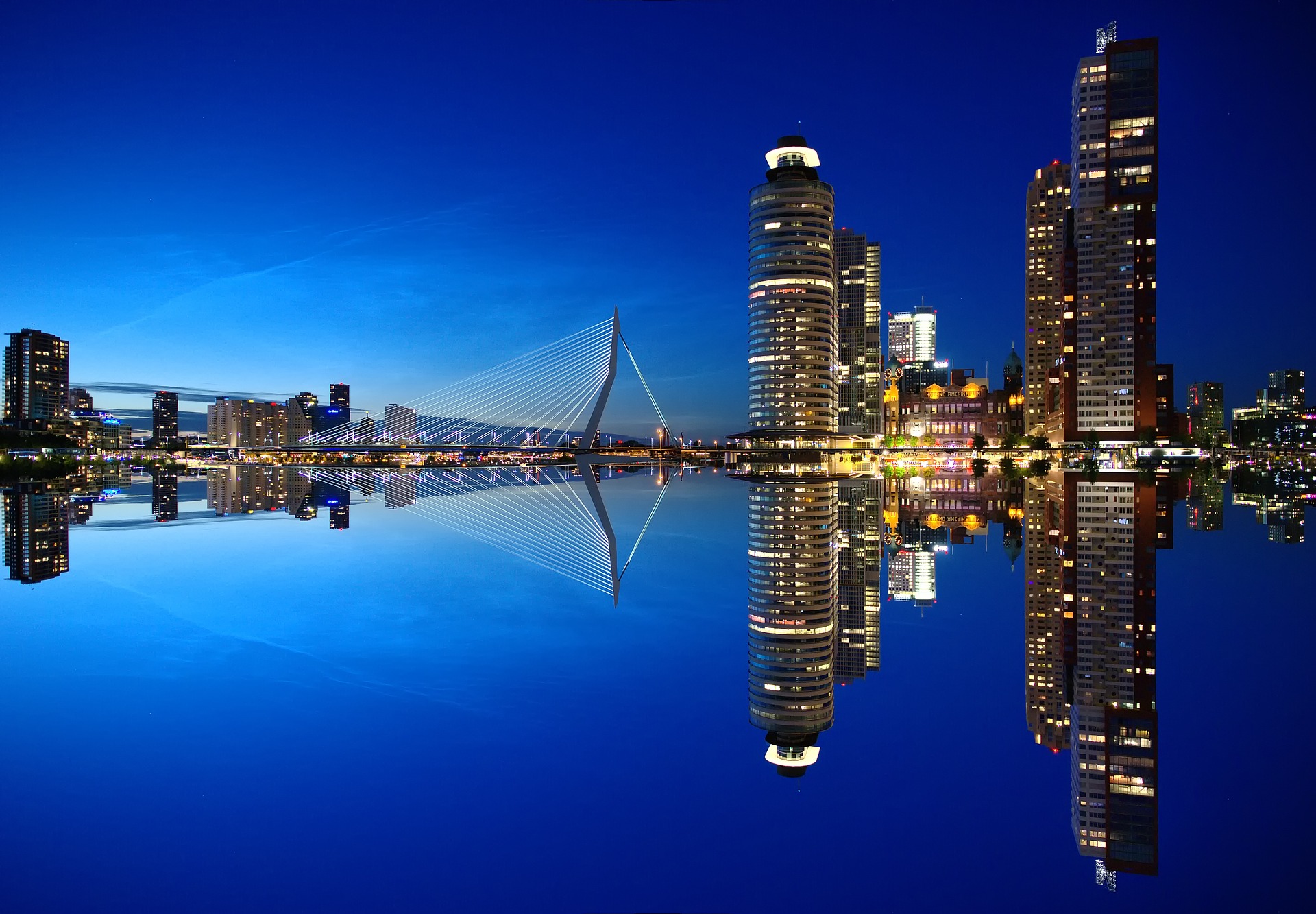
Rotterdam is the second largest city in the Netherlands. It’s the capital of the province South Holland. Rotterdam is world famous because of its port. Rotterdam has the largest seaport of Europe and tenth largest port worldwide by terms of annual cargo. But Rotterdam is more than just the port. It has great architectural and cultural value. Something you can experience yourself when you visit the market hall.
Rotterdam dates from around 950 CE when it just was a little village next to the river Rotte. Rotte, or back in the day Rotta, means ‘muddy water’. In 1260, floods were a regular thread to the citizens of Rotte. To protect the people against the threat of water, construction began for protective dikes and dams to shield the village.
Rotterdam received its city rights in 1340 by Count Willem IV. It was still a relatively small city with only a few thousand citizens. In 1350, a small shipping canal was finished and Rotterdam became an important trading location between South and North Holland. Furthermore, it were the first steps towards becoming internationally relevant by enabling trade with England and Germany. Yet, these were still small steps and the biggest changemaker was about to introduce itself.
The big changemaker was the VOC (Verenigde Oostindische Compagnie or Dutch East India Company). It initiated the growth to a bigger and more mature port. The biggest growth came from the construction of the Nieuwe Waterweg in 1872. Rotterdam expanded its canal to the south and claimed more than 20 kilometers.
The city faced a huge disaster in 1940 during World War 2. Adolf Hitler wanted to conquer the Netherlands in one day. However, the Dutch resisted and it took 5 days before the Dutch army surrendered. To hasten the capitulation, Germany bombarded the city of Rotterdam. It destroyed a large part of the city and around 900 people died. Luckily, most people fled the city days early because of earlier bombardments. In 1950, Rotterdam began rebuilding its city and choose a rather aggressive architectural approach. More about that in the upcoming chapter.
Rotterdam has the nickname ‘architectural capital of the Netherlands’ and ‘Manhattan at the Meuse’. Strong titles but not without reason. It’s impressive how Rotterdam pulled itself out of the dirt and dust of the World War 2 bombardments, and rebuild itself. The Rotterdam skyline has a magnificent feeling and reminds you of New York. This magnificence was no accident because Rotterdam made use of word-class architects like Rem Koolhaas, Neutelings & Riedijk, and Erick van Egeraat.
A couple of famous buildings in Rotterdam:
The Market Hall is a building with multiple purposes. It has a residential and office functions, but it also is a gigantic market hall where merchants show their goods. Additionally, the architectural value is high as the inside of hall has a beautiful wall painting. It’s quite something to witness. The Market Hall offers 228 apartments, 1600 m2 for restaurants, 4600 m2 for retail space. The Market Hall is designed by MVRDV, an architectural firm located in Rotterdam. In the inside, you can see a beautiful wall painting of enlarged fruits, vegetables, fish, and oils, just like what is being sold on the market. It’s made on aluminum panels and it looks marvelous! Definitely a place to check out yourself.
Cube houses or ‘kubuswoningen’ are an architectural invention by Piet Bloem. There are multiple cities with the same design. Rotterdam has its cube houses situated in the Blaak area. Basically it’s a cube that has been rotated 45 degrees and placed on a hexagon form. The goal was to optimize the inner space whilst representing a tree. All the trees combined function as a tree village. At least, that’s what the architect claims it to be.
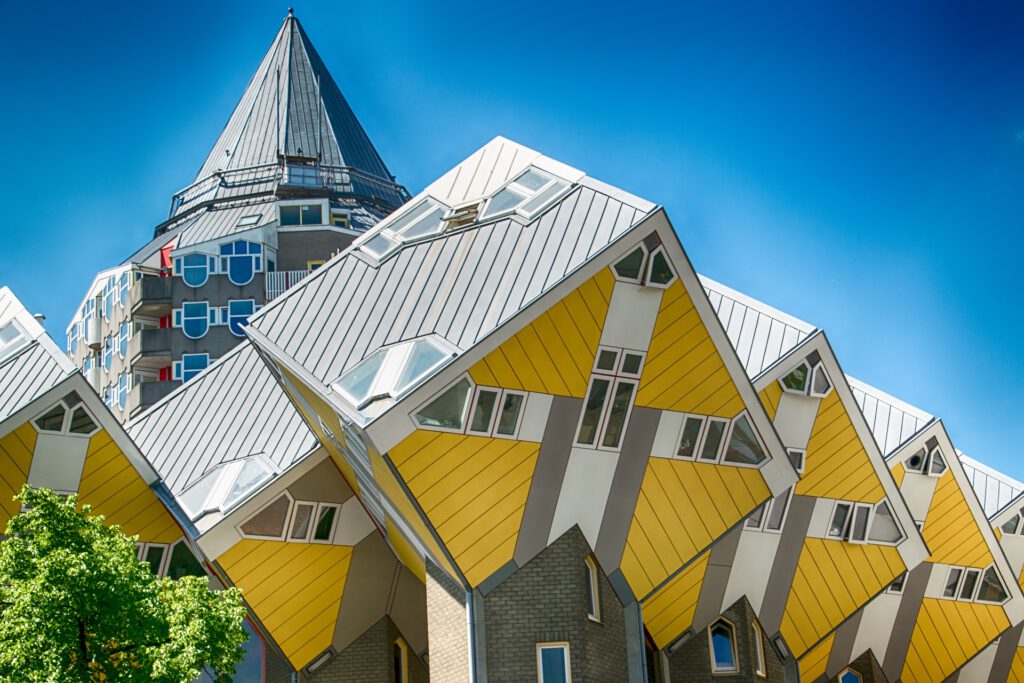
Build in 1960, the Euromast is an observation tower in Rotterdam. The Euromast is highest building in the Netherlands. It has a restaurant, hotel, and you can go abseiling. Eating at the restaurant can be quite expensive. You pay 27 euros for a brunch and 38 euros for a dinner. And the same goes for staying the night in the hotel. The suites alone cost you 395 euros per night, plus additional fees, food, and drinks, you’ll easily pay over a thousand for a weekend stay.
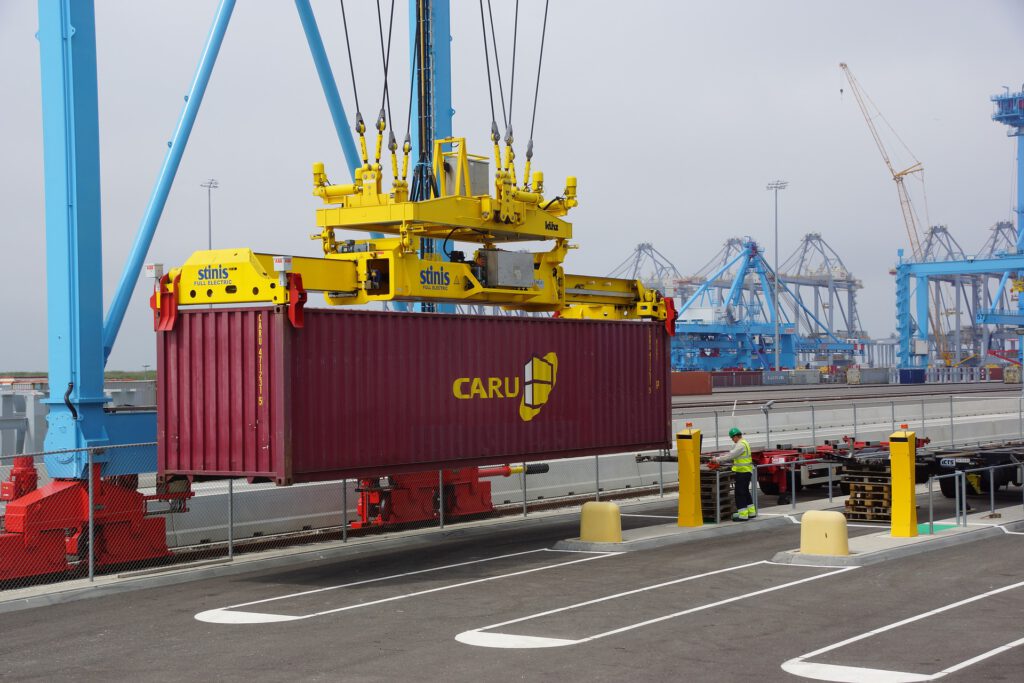
The port of Rotterdam is the biggest seaport in the world with an exception for eastern Asia. Since 1872, Rotterdam became a gigantic player in the worldwide trade thanks to the construction of the Nieuwe Waterweg. The Nieuwe Waterweg is a large canal connecting the Rhine and Meuse rivers to the North Sea. What has been secret behind the incredible success of the port of Rotterdam? Developing, constantly developing the port and expending whenever possible.
Construction of the Europoort and Maasvlakte extensions are the latest actions to secure future growth for the port of Rotterdam. Lately, the port is going more and more towards the sea on the southside of Rotterdam. From additional docks to harbor basins, the port is constantly changing and adapting to the tides of commerce. The petrochemical industry and cargo transportation have been the bread and butter of the port of Rotterdam. Goods can be transported from the port by train, road, or even air. Since 2000, the Betuwelijn is being constructed to enable freight to go from Rotterdam to Germany (and vice versa) with fast train transportation. The location of Rotterdam makes it highly competitive.
Besides expanding the port, the port of Rotterdam has also focused on innovation to beat the competition and stay the biggest seaport of Europe. Did you know that the moving of cargo at the port of Rotterdam is almost fully automated. Unmanned automated stacking cranes move the containers from the ships to and from the stacking yard. There are entire terminals where you won’t find a living soul. Besides robotics, the port of Rotterdam also invests a lot into the Internet of Things and cloud software to track and manage the logistics. The goal is to continuously improve the logistical process and maximize profit.
The Erasmus bridge is the embodiment of Rotterdam. It’s even included in the city’s logo. The Erasmus bridge connects the North and South of Rotterdam by making use of cable-stayed and bascule bridge techniques. The bridge is named after Desiderius Erasmus, a Christian Renaissance humanist also known as Erasmus from Rotterdam. Erasmus lived in the 15th century and delivered important philosophical and theological work.
To cross from south to north, the builders had to cross 802 meters of water. The Erasmus bridge is designed by Ben van Erkel. It’s a strong but yet elegant looking bridge . Therefore, it received the nickname ‘Swan’. The build began in 1986 and was completed in 1996, officially opened by Queen Beatrix. Shortly after the opening, people noticed that the bridge became instable with bad weather. Shock dampers were installed to counter the problem. Till this day, the bridge is fully functional and one of the most important landmarks of the Netherlands.
Beside a bridge, Desiderius Erasmus also has one of the most prestigious universities named after him. The Erasmus University is established in 1913 and has a total endowment of 588 million euros. It has 4 main areas: health, wealth, governance, and culture. Erasmus MC is a renown academic medical center with huge accomplishments. At the business and management side of things, Erasmus University has delivered CEO-material to established companies like Unilever.
The Erasmus University started as the Netherlands School of Commerce. It was privately funded by local businesses in Rotterdam. In 1937, the NSC got recognition as a university in commerce and economics as an academic principle. Therefore, the NSC renamed itself to Netherlands School of Economics. Rapid growth and developments in society steered the NSE towards adding other disciplines like law and history. In 1973, the different principles merged into one university and the Erasmus University was born.
A couple of noteworthy alumni are Cor Herktroter (former chairman of Shell), Frank Slootman (tech billionaire) , Ruud Lubbers (former Dutch prime minister). The Erasmus University has produced many influential leaders through the years and continues to do so. A part of this success lays in the combination of academic research and working together with companies. As a part of Rotterdam, Erasmus University has access to large enterprises like Unilever, Shell, etc. In the medical world, Erasmus MC is a combination of academic science and a real hospital. The Erasmus University is a lot more practical than most universities. That’s what makes them special.
You can’t speak about Rotterdam without naming it’s biggest football club named Feyenoord. Founded in 1908, Feyenoord is named after the city district Feijenoord in Rotterdam. It didn’t take long before Feyenoord achieved great success. They only performed for 3 years in the highest league before they became champions.
In 1937, Feyenoord build their iconic football stadium de Kuip (or the Tub). It’s a characteristic stadium where the fans are relatively close to the football field compared to other big stadiums. De Kuip has a capacity of 64,000 places. Feyenoord has one of the most loyal fanbases. Even during economic crisis , the stadium is sold out and 64,000 people are chanting the Feyenoord name. De Kuip has been the podium for many Europa League, Champions League, and National games.
In 1969, Feyenoord became the first Dutch team to win a prestigious European cup by defeating Celtic in the extra time of the final. Ove Kindvall made the winning goal. Feyenoord has been livelong rivals with Ajax from Amsterdam. This battle continues till this day. Feyenoord has a financial disadvantage and is investigating the option for a new stadium to boost their economic situation. There has been many setbacks and critique from fans. Whether Feyenoord will have a new home or not, Feyenoord remains a competitive and highly entertaining team to watch.
SS Rotterdam is a former flagship of the Holland-America line and it’s positioned in the bay area of Rotterdam. Since 2013, the SS Rotterdam is part of WestCord Hotels but the ship has been around for a lot longer. In 1959, the SS Rotterdam began its first voyage to New York. The trip was a huge success and this was celebrated by everyone aboard including crown princess Beatrix. The SS Rotterdam continued its voyages for decades until 1990s. In 1990, the safety requirements became too strict for the SS Rotterdam to pass. It was renovated by a new owner and it sailed to the Bahamas until the owner went bankrupt. In 2008, the ‘Grande Madame’ is back in Rotterdam and it still is. Today, the SS Rotterdam functions as a hotel and entertainment facility to a wide audience. It can be booked for meetings, but you can also try its escaper room. I’m glad the SS Rotterdam is back to where it belongs, in Rotterdam.
So, what about the cost of living in Rotterdam? Is it any cheaper than Amsterdam? Well, I am afraid not. Rotterdam is economically strong, has great architecture, and plenty to do. So, no there is a lot to love and that’s why you pay a price for living in Rotterdam. Students easily pay 1000 euros per month. For expats, this price will easily triple. Decent apartments start around 1500 per month, however, premium apartments start around 3000 euros per month. You can expect to pay at least 600,000 euros for a decent house. There are cheaper options but often these are situated in bad neighborhoods. Especially the different ‘kades like the Wilhelminakade are expensive. That’s mainly because it lays next to the river and you’ll have a perfect view on the city of Rotterdam. Groceries and public transportation are normally priced and not a lot different to the rest of the Netherlands.
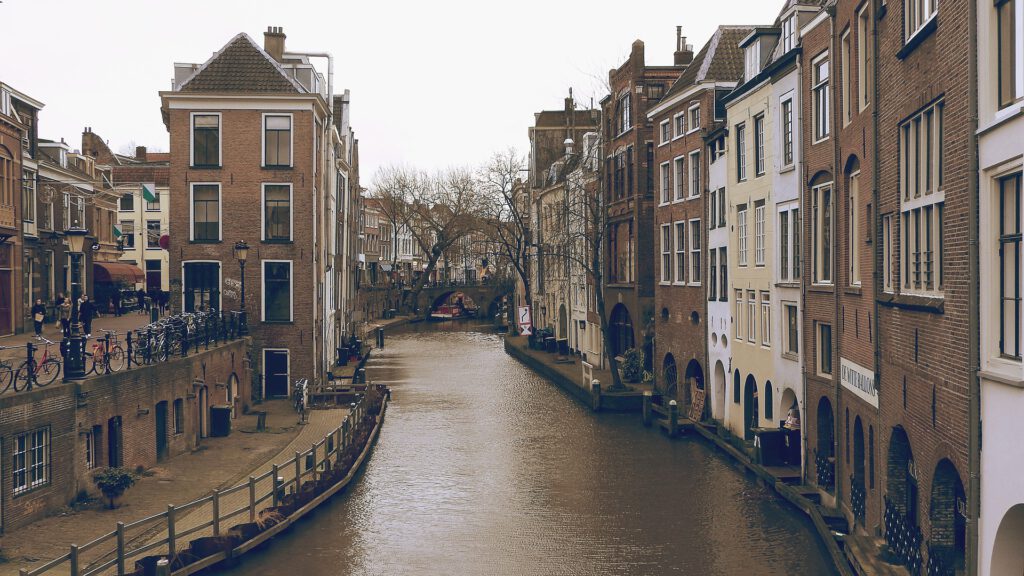
When you plan to live in Utrecht, you will live in the centre and heart of the Netherlands. With its unique position, Utrecht is also a great place for people to meet and companies who’d like to be in an easy-to-reach position. Utrecht has a very medieval vibe and a friendly atmosphere with lots of Christian monuments. It also has tree-lined canals, so taking a beautiful kayak tour is highly recommended! The canals go from north to south, where the south end is quieter. Utrecht is great for both cycling and walking on these beautiful streets, where it’s not as touristy compared to Amsterdam. Utrecht resembles Amsterdam in terms of architecture and canals, but then it’s more affordable and less crowded.
First of all, Utrecht is the bicycle capital of Europe. And this starts to make sense, as there are more than twice as many bicycles than residents! Utrecht also has the largest bicycle parking garage in the world with over 12.500 bicycles on three different levels! Therefore, bike riding is super common in Utrecht as this place is very bike-friendly with a big amount of bike lanes. But make sure to lock up your bike so it doesn’t get stolen, and embrace this bike culture. You can easily get a second-hand bike as well. Every day, over 125,000 cyclists ride to their destinations and there are 22.000 biking places near Utrecht Central Station! Also, 60% of people go to the city centre by bicycle.
Furthermore, did you know that Utrecht is a very family-friendly city? It has many schools all around, and there’s even an international school. This school is more expensive than usual is it costs about 7000 euros per year to get your kid here to school. Everywhere in Utrecht, there are places where children can play, such as playgrounds or skateparks. And for the teenagers and (younger) adults interested in nightlife, Utrecht also has to offer a popping nightlife with an array of festivals. Anyways, Utrecht is one of the most attractive places to live in the Netherlands. And even for those who seek peace, Utrecht can be the perfect place to live as it is also surrounded by peaceful neighbourhoods, filled with history. And a fun fact: Utrecht is also a province, and the smallest province in the middle of the Netherlands!
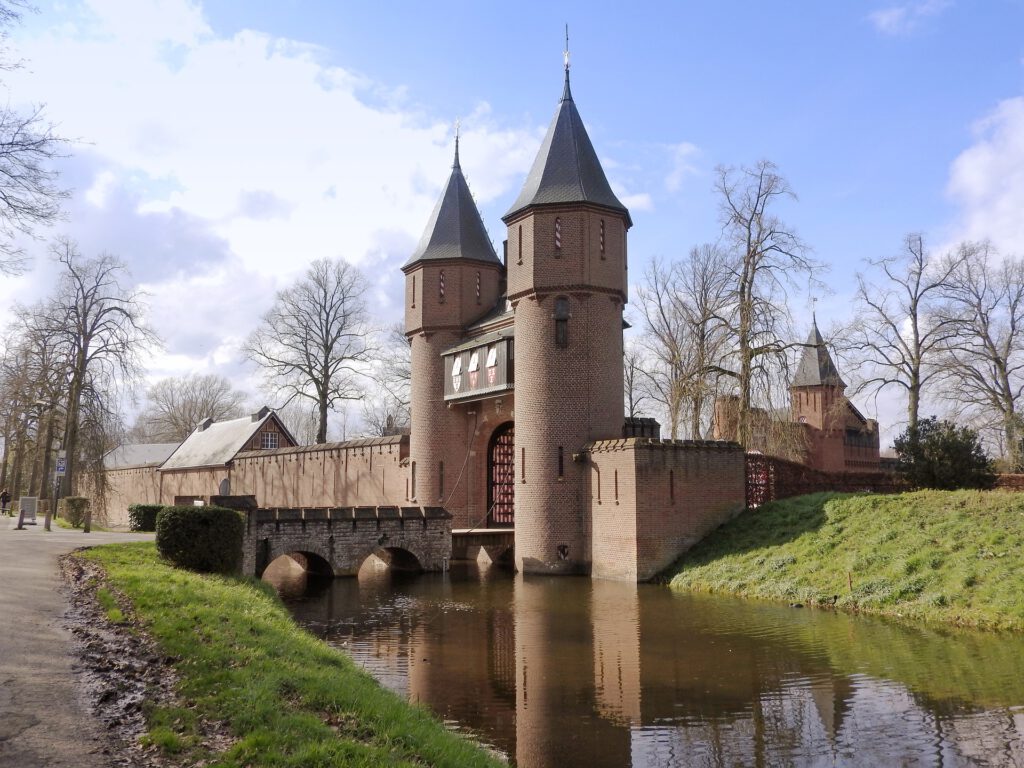
Utrecht is a modern university town with a long history. We will help you to get a glimpse of this rich medieval history across many different levels. All around Utrecht, you will find museums, galleries, and lots of restaurants and cafes. Due to this medieval vibe, Utrecht inspires both culture and shopping fans too. Let’s dive into the must-visit areas in Utrecht!
The Dom is the highest church tower in the Netherlands and the highest building in Utrecht. Therefore, once you visit Utrecht you will notice this building immediately. It comes from the 14th century and it is the heart of the old city centre. It takes you 465 steps to reach the top of the tower. Currently, they have also made an elevator which is a temporary lift to the top of the Dom Tower. This takes you to the top in just 3 minutes! The Dom Utrecht is a great place to enjoy the beautiful view of Utrecht at a height of 100 metres. You can only visit the tower as part of a guided tour, where you will be taken on a historical journey. This 1-hour tour starts in the Tourist Information Centre on Dom Square.
The St Martin’s Cathedral is Utrecht’s beautiful cathedral that is also known as the Dom Church. It is a great restful place in this beautiful city. Once, it was the largest church in the Netherlands that resembles the style of classic Gothic architecture. When you have seen the Dom, you’re probably wondering why the Dom tower is separate from the cathedral. The Dom used to be one building with the cathedral. But in 1674, a violent storm including a tornado had split the building in two! The nave collapsed, and the tower has never been rebuilt ever since.
Therefore, the Dom tower is separated from the cathedral. There are free classical concerts held there almost every week with an impressive organ. During the time the music is played, it is not very appropriate to leave the church or walk around as the audience seems pretty serious. Inside the cathedral, you will also see beautiful Gothic architecture and stained glass. You won’t see something like this quickly anywhere else in the Netherlands.
There is only one square that matters in Utrecht: the Dom Square. It’s the beating heart of Utrecht, and it has the collapsed nave plotted out in a pavement. Also, a high recommendation is to go ‘’dom under’’ meaning you can go underground and learn about 2,000 years of Utrecht history! And if you’re interested in the square’s best-kept secret, you can visit Dom’s Pandhof. This is a monastery garden full of flowers and herbs. It is a hidden garden that’s located between the Dom Church and the Academy Building. It is one of the most beautiful courtyards in the country! Furthermore, from here you will have a stunning view of the church and the Dom Tower as well. It’s not for nothing that this is an award-winning location.
Utrecht also has a wonderful market, called the ‘bloemenmarkt’, which means flower market in English. This beautiful flower market is held every Saturday in a unique location on the Janskerkhof, which is on a nice square just next to the city centre. About twenty stalls sell cut flowers and all kinds of plants that are of great quality. There’s something there for everyone. Depending on the season, the flower market also sells seeds, bulbs, and cuttings. It is a pleasure to walk through the market in a relaxed manner and enjoy the wide variety of colours and great prices, all in a nice atmosphere. The market holders are friendly as well. This cosy market is a colourful attraction in the heart of the city.
Another well-known market in Utrecht is called ‘de lapjesmarkt’, that’s held on the street called breedstraat. This market consists of a very extensive range of fabrics and haberdashery. The assortment on the market varies, which makes it worth visiting this market every week. And as we’re used to with the markets in Utrecht, in this market you will experience a friendly atmosphere as well. De lapjesmarkt is very good and it’s one of the few patch markets that’s left in the Netherlands. Prices go from 3 euros per meter to even 95 euros or more. Usually, the markets end at about 1 pm.
Remember I told you that Utrecht had the biggest bicycle parking garage in the world? Next to it, lies the largest train station in the Netherlands: Utrecht Central. It has 16 platform tracks which make it the busiest station in the Netherlands. But what’s even more exciting is that Utrecht has a railway museum, called ‘spoorwegmuseum’ in Dutch. And it’s much more than just a museum. In this fascinating place, you will discover how trains have changed the world, and it’s built on a real-life station. You will find a variety of temporary exhibitions and events, exciting attractions, a theatre, and more. It will surprise you how amazingly well these trains are put together.
The Railway Museum is proud to illustrate the vital link between the railways and society. Initially, this museum was located in one of the main buildings of the Dutch National Railway. The Railway Museum is a must-visit for people who want to find out more about trains, and kids will be entertained as well as they can hop on some of the trains that are driving outside. You will go back in history, where the employees can tell you everything about the trains. Usually, a visit to Utrecht’s railway museum will take about 3 hours.
The Utrecht University is worth mentioning, as it is the largest university in the Netherlands and one of the leading research universities in Europe! For 11 years, the University of Utrecht has ranked in the top 70 worldwide. Many (international) students come and go to his impressive university. It is firmly founded on tradition and it’s actually one of Europe’s most prominent institutes of education and research. It has 109 Master’s programs and 49 Bachelor’s programs that offer a broad spectrum of quality teaching and research. Some top faculties that Utrecht University is well-known for, are Radiology, Public Health, Toxicology, Pharmacology, Social Sciences and more.
When you’re interested in beautiful green nature and peace, you can visit Utrecht University Botanic Gardens. Here you find six unique gardens in a 22-acre delightful site. There are tropical greenhouses, and gardens named the Birders Den, which is popular among bird-watchers, and Bee Hotel that has a wide variety of pollinating insects. You can visit these gardens from spring till December. And to get the most from your experience, you can decide to take a guided tour and finish your day with a drink at the pleasant Garden Café. These gardens have their roots back to the 17th century in the early days of Utrecht University.
Maybe you didn’t expect this, but Utrecht has many castles. Most buildings at the Oudegracht are castles! The Oudegracht is also called the old canal, which runs through the centre of Utrecht. Why were there so many castles in Utrecht? This is because Utrecht used to be the biggest and most important city in the Netherlands, around the year 1175. This resulted in attracting wealthy people, and more castles were inhabited by people who were in the army or worked for the bishop. The most beautiful fairy-tale castle in the Netherlands is De Haar Castle, called Kasteel De Haar in Dutch. It’s a must-visit place where you can take lovely pictures.
The same architect who designed the Rijksmuseum and the Central Station in Amsterdam designed this beautiful castle. He is called Pierre Cuypers. It is not the original castle, but Pierre Cuypers did a great job at rebuilding and imitating this castle in the medieval style. Also, before Beatrix became queen, it was a private property of her and she lived here for quite some time! She also lived here after she resigned from her function. Furthermore, this castle hosted countless international celebrities including Brigitte Bardot and Maria Callas. When you visit this castle, enjoy the impressive building, medieval atmosphere, many rooms with accessories including beautiful original wall hangings from the 16th century, and wonderful gardens.
I told you that Utrecht is rich in history and museums, and the St. Catherine’s Convent museum is worth mentioning. It shows a rich collection of very old medieval art, that consists mainly of religious art. For example, paintings of reformist Christian artists who were reflecting on the essence of the break with the Catholic Church. Furthermore, this museum has statues, spiritual pictures, and treasuries that are all well displayed and presented. You will get to know the ideas behind medieval Dutch artefacts and their meaning. So, if you’re interested in medieval art or the history of religion in the Netherlands: this museum will be a must-visit.
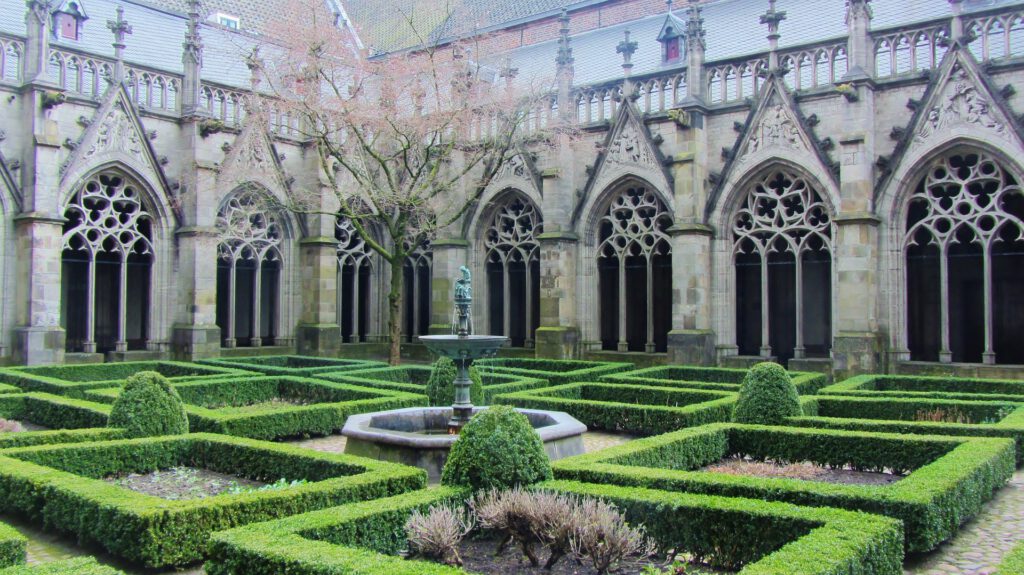
How expensive is it to live in Utrecht? Utrecht is the 2nd most expensive city to live in the Netherlands. And also in Utrecht, houses are in high demand. But compared to the most expensive city in Europe: Amsterdam (capital of the Netherlands), houses start a lot cheaper. On average, they start at the cost of 300.000 euros which is 200.000 cheaper than Amsterdam. Furthermore, the price range highly varies depending on where you live. For example, if you rent a one-bedroom apartment in Utrecht inside the city centre, you will easily pay about 1200 euros per month, whereas outside the city centre it drops to 970 euros per month. And if you’d like to rent a three-bedroom apartment, prices usually start around 2200 euros per month and outside the city centre, it will be around 1500 euros per month. In any case, when you’d like to live right on the water in a canal house, you have to pay for it.
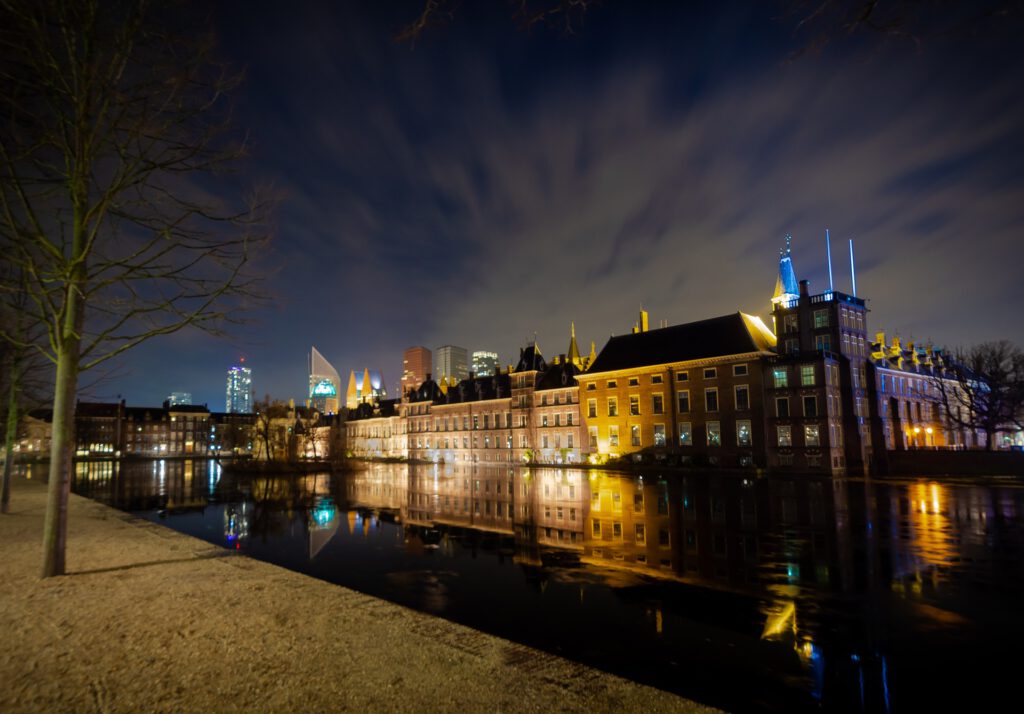
The Hague or ‘Den Haag’ is the political capital of the Netherlands and seat of the Dutch parliament. It has always been a curious situation with the Hague because it has been the central piece of the government since the 1200s, but it has never been the capital of the Netherlands. A part of the answer lays within the origins of the city. The Hague was founded by the last counts of Holland. Floris IV owned multiple residencies in the area around the Hague. He purchased a court that is now know as ‘de hofvijver’ (where the modern government resides) and wanted to transform the court into a castle. However, he died in a tournament and his son took over. Willem II lived in the court and transformed it into a palace. These rooms are still being used by modern politicians to govern the Netherlands. The prime minister is situated in ‘het torentje’ which is the tower of the court.
In the 80 years war, the Hague was a weak spot for the Dutch army because the city didn’t have city walls. Therefore, it was difficult to defend against the relentless attacks from the Spanish army. The State of Holland considered to demolish the city. Luckily, after meditation with Willem van Oranje the city became vacant and was taken back by the Dutch. Short after, the provinces united under the name of the Dutch Republic. The Hague became the capital city of administrative duties such as government and law.
The Hague University of Applied Sciences, or THUAS, with multiple campuses around the city of the Hague. Established in 1987, THUAS is home to 26,000 students and 2300 staff members. THUAS is one of the larger Universities of Applied Sciences. THUAS is highly international as there are 124 nationalities represented on the campus. The University has great relationships with businesses, legal institutions, and government bodies because of the Hague.
THUAS has the following faculties:
Universities of Applied Sciences are less academic and focus on practical experience by combining learning and doing internships at businesses or organizations. To get more value to the students, THUAS is continuously investing in new contracts with other universities to enable student exchange. THUAS scores a 3.8 stars out of 5 according to students review portal.
An important factor about living in a city is the accessibility. The Hague is accessible by sea, road, and air! The latter is called the Rotterdam the Hague Airport. It’s located in Rotterdam but it functions as the airport for both Rotterdam and the Hague. It’s a great little airport that is less overwhelming than Schiphol. Additionally, there are many flights available to you. Whether you want to fly to your vacation destination or hometown, many destinations are possible. It’s also possible to land your private jet on Rotterdam the Hague Airport.
The Hague has multiple beaches for you to enjoy. From excitement to relaxation and piece, the Hague beaches offer something for everyone. In this chapter, we are going through a couple of the most popular choices. There are many more beach locations available. For a full overview, take a look at Google maps or Google the local government website.
The three main beaches of the Hague are:
Scheveningen is ideal for relaxation and eating at one of the amazing beach clubs. In the summer it can be quite a mad house because the whole country will come enjoy Scheveningen beach. Zuider strand is popular among locals and less known to tourists. It’s great for calm and peaceful walks to clear your mind or spot beautiful seabirds. Kijkduin is popular among kite surfers and dog owners. There is a lot of space on the beaches and you can make use of the facilities offered by holiday entertainment companies.
Besides the skyline and the countless buildings that make the Hague the vibrant city it is, there is also peace and quiet to be found along the shores. Scheveningen beach is without doubt the most popular beach. It’s quiet and peaceful in the winter. Great for a walk to clear your mind and reset from a busy work life. In the summer, the beach changes to a hotspot that attracts the entire country (and even Germans!). The beach clubs provide delicious food and beverages to cool you down during the hot summer.
So, what are the best beach clubs in Scheveningen? Which should you definitely check out? Here is a list of the best beach clubs in Scheveningen. They are selected on food quality, ambiance, and scenery.
Beach club Bliss can be found on the topside of Scheveningen boulevard and is known for the comfortable outdoor lounge and relaxing music. It’s great if you like a social club that feels alive and accessible for everyone. Especially in the summer, Club Bliss is highly popular and you’ll need to claim your spot early. The food is good and not too expensive.
Blue Lagoons was loved and that’s why many hearts were broken when the beach club had disastrous fire that destroyed the place. It’s amazing that in less than a year, the Blue Lagoon in restored and ready for the summer. It’s better than ever before. The interior looks warm and comfortable with the typical lagoon blue color. You can enjoy fine Jazz music or eat delicious North Sea fish.
Carlton beach club is part of the hotel and known for luxury and premium food. You can make use of all the facilities even if you are not staying at the hotel. The Carlton offers you equipment to go into the water and surf or kite, but you can also rent a bike and go for a nice ride. When you return, you can take a bite at the Grill & Bar to enjoy fine dining. There is even a sport facility to get rid of the calories you just added. The Carlton beach club is for more prestigious visitors.
Popular among locals, Zuider strand is the most peaceful beach in the Hague. It’s especially great for people that are done and tired from work. A long peaceful walk along the North Sea will reset your mind and recharge your mind. Additionally, it’s a great place to go if you have a dog. No tourists or watersport enthusiasts that are in your way. Just you, your dog, and the peaceful North Sea breeze.
Kijkduin is ideal for thrill seekers and watersport enthusiasts who enjoy kite surfing or wind surfing. It’s a busy place but there is enough space on the water to enjoy your sport and not get into each other’s way. Kijkduin also has the Kijkduin vacation park which is directly located next to the beach. Close to Kijkduin is the Zandmotor. Be aware of this place because there is a strong current and quicksand. Always keep an eye out for the warning signs.
So, how does the Hague compare to other big cities when we look at cost of living? The Netherlands isn’t cheap, especially when you live in the Randstad area near the 4 biggest cities. However, compared to Amsterdam, Utrecht, and Rotterdam, the Hague is a lot more affordable. It has great (international) schools and Michelin-starred restaurants. Prices for properties start around 300,000 for small houses in the Hague. Certain areas are more expensive as they offer luxurious villas for diplomats and other government officials. These houses can easily cost 1,000,000 euros or more. You can find our listings here.
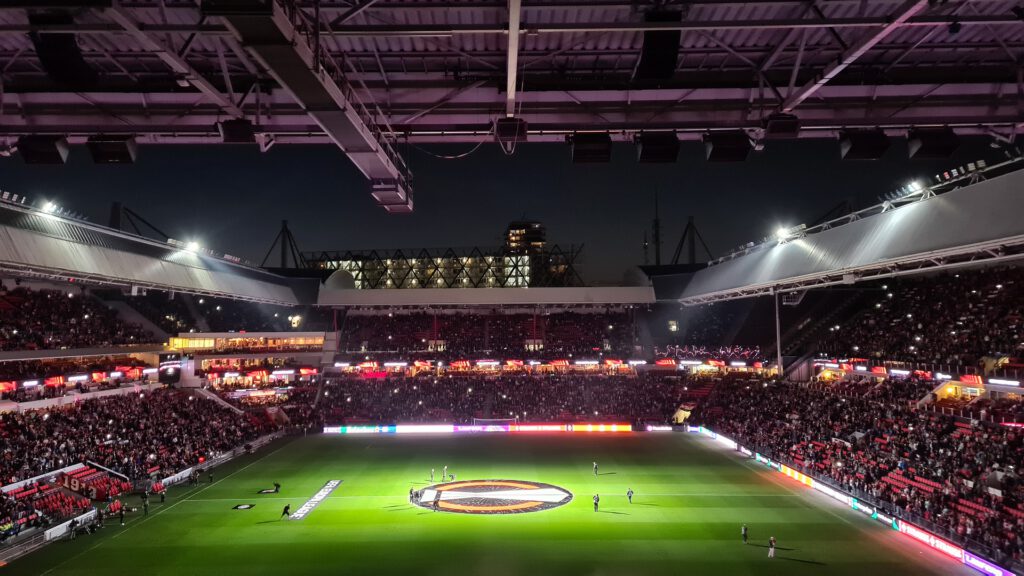
Eindhoven is a city in the south of the Netherlands. It’s word famous for its innovative nature and the many promising tech companies that are situated in Eindhoven like ASML and Philips. Additionally, it’s the home of the football club PSV (Philips Sport Vereniging) and Eindhoven is the fifth largest city in the Netherlands. It also suffered a lot during World War 2 and many civilians got hurt by bombardments. It was a strategic position to the allies to liberate the Netherlands.
In the 13th century, Eindhoven was a small farmers village. The written history starts in 1232, when duke Hendrik I of Brabant granted Eindhoven its city rights. It was a small village of approximately 160 houses and a small castle. However, it was an important piece in the trade between Holland to Liege. Eindhoven has been attacked and damaged on multiple occasions. The most severe attack came from the Guelders (neighbor province). As a reaction, Eindhoven constructed city walls and upgraded their castle to defend the city from these raids.
In the 80 years’ war, Eindhoven continuously changed from owner between the Spanish and Dutch troops. During the Dutch revolt, Eindhoven was once more attacked and burned to the ground by Spanish soldiers. It’s actually amazing how many times Eindhoven got burned down, but yet never gave up and rebuild over and over again. The many throat punches diminished Eindhoven’s growth and the city remained small until the industrial revolution.
In the 19th century, Eindhoven invested a lot of resources in building a proper infrastructure for rail, road, and canals. This released a massive growth impulse and Eindhoven took off! The business was centralized around textile and tobacco until something massive happened. Lighting grew exponentially and this was good news for the Eindhoven based company Philips. Philips’ growth exploded and so did Eindhoven.
Due to this growth, Eindhoven needed to expand beyond their city walls and construct new housing projects to keep up with the demand. The population grew from 2000 citizens in 1820 to 46,000 in 1920. Unfortunately, things couldn’t keep going Eindhoven’s way because World War 2 took place. Eindhoven was hit hard because of its industry and hundreds of civilians got killed due to air bombardments by the Luftwaffe and the RAF. A large part of the city got blown to pieces and have to be rebuild after the war was over.
If you want to live in Eindhoven, then it’s probably a good idea to check in with the local government. You can find them at the ugliest building of whole Eindhoven, the Eindhoven city hall. The address is Stadhuisplein 1, 5611 EM, Eindhoven. You can contact the authorities if you want to move in or out of Eindhoven. Furthermore, you can get permits like parking and get information about living in Eindhoven.
Eindhoven Airport is located on the westside of Eindhoven. It’s founded in 1932, and it was a key strategic location for both the Germans and Allies. Germany quickly took Eindhoven Airport in the beginning of the war. They improved the infrastructure and expanded the airfield to strengthen the Luftwaffe and carry out more attacks at England. During Market Garden, the Allies captured the airfield and used it to carry out attacks. It was only in 1984 that civilian flights were able from Eindhoven Airport. It rapidly continued to grow and today it’s the second largest airport in the Netherlands. Many people favor Eindhoven as it’s smaller than Schiphol and therefore less stressful. Eindhoven has many flight destinations and is being used by large air travel companies. It also continues to be a military airfield with mainly transport planes being stored in a separate area of the airfield.
In 1891, Philips was founded by Frederik Philips and his son. They recognized the opportunity that the newly invented electricity had to offer. Together they went to work and designed a cost-efficient light bulb. This was the small start of a global company that now is mainly active in the medical world. Philips got traction and became the largest employer for work. More than 2,000 employees were active at Philips. This brought massive growth to the city of Eindhoven and its surroundings.
Innovation and research has been the key since the start of Philips. In 1914, the Philips Nat Lab was opened and this is the birthplace of the legendary X-ray tubes that initiated the growth of Philips in the health technology sector. But that’s not where the company solely focused on. No, they entered more markets like radio. Philips radios were from high quality and are still popular to this day. In 1930, Philips introduced the electronical shaving machine, or Philishave (yes, not the best name…) They sold out their entire stock in a matter of an hour.
After the World War, innovation took off and many new inventions came to the market like portable cassette audio players. Again, this was a huge success and Philips set the tone for the rest of the world to follow. Philips has always been good in feeling where innovation is going. Rather than waiting for things to be invented, they took it upon them to lead the way into a new tomorrow. Today, Philips focusses on health technology and has separated its lighting business. The goal is to make medical technology accessible for every household.
Eindhoven University of Technology (or Technische Universiteit Eindhoven) is one of the most prestigious technology and engineering universities in the Netherlands. It has approximately 13,000 students enrolled and 3000 staff members employed. The Eindhoven University of Technology has been ranked among the top 200 best universities in the world for multiple faculties.
Eindhoven University of Technology has been lifelong rivals with the Delft University of Technology (or Technische Universiteit Delft). The TU Delft was the first university of technology in the Netherlands. Battles are being fought in engineering and science tournaments between Eindhoven and Delft. Eindhoven University of Technology has 9 departments.
TUE is one of the best-performing research universities in the world because it works closely together with industry partners like BrainPort Eindhoven. Additionally, it has good relationships with universities from all over the world e.g. China and Singapore.
BrainPort Eindhoven is known as the home of pioneers. BrainPort Eindhoven is the place where high-tech manufacturing meets the design sector. Working together in an innovative environment to push technology to the next level, that’s what BrainPort is all about. It enables small scale production of innovative products to be build and tested. The goal is to ultimately bring new inventions to the market and improve human life.
BrainPort is built upon teamwork between industry, education, and local government. Even the royal family is connected to BrainPort to promote it both nationally and internationally. By making use of the knowledge and equipment of partners, innovation is going in a much faster pace than normally. Lately, sustainable energy and transportation have been important topics where money and hours being invested in.
The international perspective and the strong focus on export have been success factors for the BrainPort system. This results in a broad network of local suppliers and customers that work closely together with other (innovative) regions in the Netherlands and internationally. BrainPort is smartly using the opportunities provided by globalization. Therefore, they service global niche markets and securing employment for engineers.
The cost of living in Eindhoven is a lot better than in Amsterdam or Rotterdam. In the south of the Netherlands, prices are lower as it’s further away from ‘de Randstad’. You’ll need to earn at least 1800 per month to live comfortable in Eindhoven. Of course, it all depends on your lifestyle. You can go as crazy as you want in Eindhoven. Luxury apartments will cost you around 1,200,000 euros. However, you can also buy homes starting at 200,000 euros. The centrum is the most expensive and the regions around Eindhoven are more affordable. Eindhoven is very much upcoming because of Brainport and Philips.
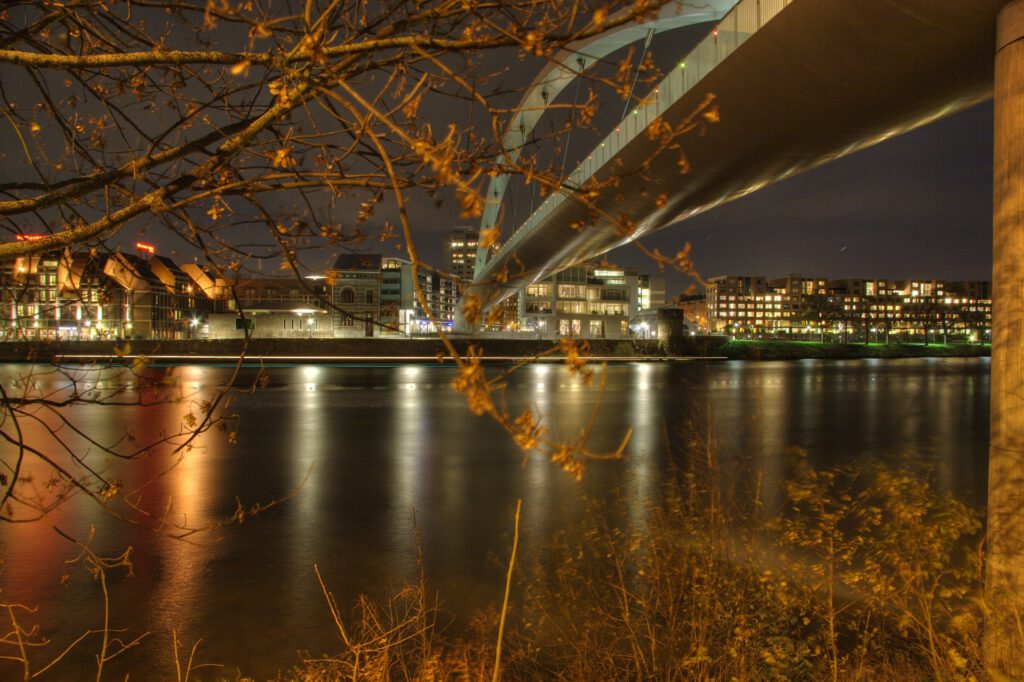
Maastricht is the best-kept treasure of the Netherlands. It’s the oldest permanently inhabited city in the Netherlands! You can reach Maastricht from Amsterdam in a 2,5 hours drive. Maastricht is a lovely place, with all its monumental houses, beautiful buildings, and many squares. And even though it’s located in the far south of the Netherlands, it lies very centrally. This is because it lies in the heart of Tristate city, which is an international urban area. This area has one of the biggest economies in the world. The Maas-Rijn region is one of the most densely populated areas.
When you walk through Maastricht you start to feel the history. Once, it all started as a Roman settlement because of its strategic position. What’s interesting, is that you will discover multiple languages in one city! It’s not uncommon to hear German, French, English, and Dutch: all in the same alleys. Millions of people discover Maastricht every year. And Maastricht has an amazing, historic university that attracts students and researchers from all around the world. 50% of the students of University Maastricht are foreign students! The whole university works on a healthier, smarter, and more sustainable Europe. So you can tell it’s a famous city among students, too. By the way, other famous student cities in the Netherlands are Leiden and Utrecht.
Maastricht is a very tidy, and well-located city in the province of Limburg, that’s nestled between Germany and Belgium. The central location in Europe makes it easy for residents to take trips through the rest of Europe. The city is also known for its great quality of life and therefore it’s not surprising that it is becoming increasingly popular among ex-pats worldwide. Also, there’s a big influx of multinational companies. As a result: more and more jobs are there to be picked up. Because the city is so compact, you can easily get to the city centre by bike, even if you live outside of the city centre. Inhabitants also agree that Maastricht is the most intimate metropolis in Europe. Because just around the corner, you can also find yourself in beautiful peaceful nature in the hills of Limburg.
In Vaals, a municipality in Maastricht, there’s a border triangle where the borders of Germany, the Netherlands, and Belgium come together. At the same time, it’s also the highest point in the Netherlands: a height of 323 metres! On the Dutch side, you will find the Wilhelminatoren that’s 34 metres high. Once you reached the top after passing the 181 steps you will get on the sidewalk with a glass floor, where you’ll get the most stunning views. Because of the glass floor, they also call it the ‘’skywalk’’. You will get the chance to get views of all 3 countries! It costs about 4 euros per person to climb the tower and good to know is that it also has an elevator. It’s an exciting area for children too, as they can climb the tower or make use of the playground.
And very important: Maastricht is the birthplace of the European Union, in 1992. During this year, multiple European leaders came here and signed the famous Maastricht treaty. The mission of Maastricht is simple: to bring Europe closer to people. And they are still doing this today. Maastricht has also one of the biggest art fairs worldwide: the European fine art fair. The city is also full of historic monuments, and it’s known for its traditions and sense of community. Just to name some of their traditions: Vastelaovend (carnival), André Rieu (summer concerts), Manus van Alles (multicultural festival) and the Sint Servaas Processie (religious procession).
Maastricht has a lot to offer. From museums, vibrant squares and alleys, to wonderful medieval architecture and history: it is all here. As soon as you walk through the cobbled old town you will feel the medieval vibe. Also an interesting fact: Maastricht is the largest city and capital of the province of Limburg, located on both sides of the Meuse (Maas in Dutch) at the point where the Jeker joins it (river in Belgium and the Netherlands). Let’s dive into the must-visits in Maastricht!
Vrijthof is the main square of Maastricht only since the 19th century. And of all squares in Maastricht, this square tops them all. Plenty of folks enjoy the scenery here every day. It’s a great place for many people to go and enjoy life after a hard day of work or in their leisure time. Before, Vrijthof was an ancient Roman and Frankish cemetery that developed into a semi-private space. This space belonged to the Collegiate Church of Saint Servatius.
Vrijthof is a must-visit, as it is surrounded by museums, a range of hotels, a theatre, heritage buildings, and many bars and restaurants. This large urban square is also used for public events, like a concert of André Rieu. The traditions we talked about before are usually held at the Vrijthof square. When you are at Vrijthof, you can also enjoy the gigantic old cathedral and its surrounding fair. Furthermore, you will spot the Gothic-style church called Saint Jan’s church which is known for its red tower.
Would you like to see archaeological finds from the province of Limburg, very old paintings of South Holland, or sculptures from the Maasland? Then you should have a visit to a magnificent building called the Bonnefanten museum. This museum offers a wonderful mixture of art, with new and old artefacts that come from the middle ages (1300-1500). It also shows a representative collection of classic Dutch paintings. The collection is presented very well in a well-thought layout. It is easy to walk to this museum as it lies on the main street on the riverside. For example, when you are at Maastricht’s main square called the Vrijthof, it takes about 22 minutes to get there. Bonnefanten museum also has exhibitions that change quite frequently.
Local people in Maastricht and entrepreneurs say that you won’t need to get told if you got into the Jeker quarter (jekerkwartier in Dutch). Because they say you will notice this immediately once you get there. In this district, the historic Maastricht shows itself from its best side. The Jeker quarter is a neighbourhood in the old city centre of Maastricht that’s named after the Jeker river. This river flows through the neighbourhood into the Meuse. Anyway, the Jeker quarter is hidden between the city walls and ancient monuments. The beautiful buildings, fine terraces, and medieval fortifications make the Jeker quarter a wonderful neighbourhood to visit. A walk through this neighbourhood is very diverse! There’s also a high chance you come across projects by young entrepreneurs.
Close to the Jeker quarter you will find the City Park. It is a lovely place to start the day, relax, and get a taste of the atmosphere of Maastricht and enjoy the peace. You will have a good view of the ancient city walls, which you can climb there. The city park of Maastricht lets you discover the rich history and shows you some of the great beauty that Maastricht has to offer. The city park can be best described as a riverfront park with scenic views. And if you’d like to grab a coffee, the best is to walk to the Sint Pieterstraat. Because here you will find one of Maastricht’s most favoured terraces.
Another interesting park in Maastricht is the Frontenpark. Usually, when we think about parks, we think that it’s tightly laid out or stately maintained park. But this is not what Frontenpark looks like. No, it is a rough piece of nature that existed because no one was maintaining the park. Nature had all the freedom to go its own way and this has turned the Frontenpark into something completely different. So if you’d like to get another nice green break, where you’re also being on old city walls, you should have a visit at the Frontenpark. You will be reminded of the fact that once Maastricht once was a former fortress city.
Close to Maastricht’s city park, you will find the Natural History Museum. This is a small museum but it has interesting exhibits. For example, of whales. Did you know that the Netherlands used to be at the bottom of a large sea? Therefore, there are plenty of aquatic fossils in the area. In this exhibition, you will get to know much more about the Seaworld and its swimming predators. You can even combine your trip to this museum with a walk through the small but beautiful city park. The old city walls make a great backdrop for this lovely wooded and grassed park, and there’s a nice fountain there.
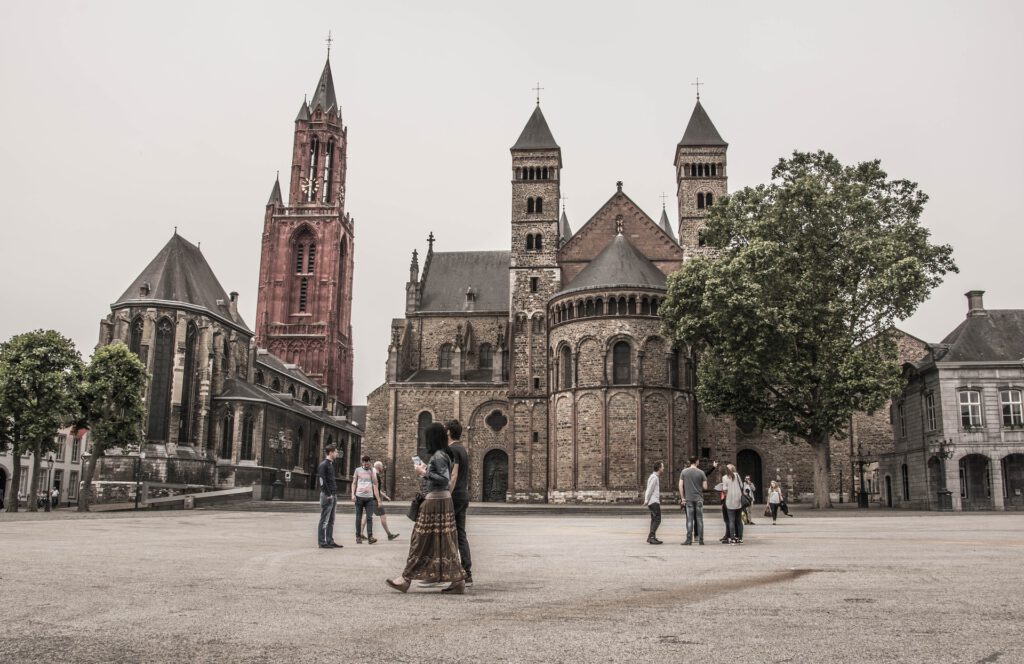
Two beautiful, peaceful churches and monuments in Maastricht are called the Basilica of Our Lady, and the Basilica of Saint Servatius. As you know, Maastricht has a long history. So it isn’t strange to find 2 famous basilica’s.
The Basilica of Our Lady dates back to the 11th century, but nowadays it’s a modern city church in the city centre of Maastricht. It is a renowned Roman Catholic basilica. It has a stunning interior with many painted wood sculptures. The dim lighting gives it an ever more calm and serious feel. When you decide to sit in the pews and light a candle, you will get the full experience. The main attraction of the Basilica of Our Lady is the miraculous statue of Our Lady, Star of the Sea. It is also a part of Holland’s biggest museum. The artwork and the architecture make it worthwhile to visit this church. It’s situated at the Our Dear Lady Square which was once voted for the most beautiful square in the Netherlands!
The other impressive church, called the Basilica of Saint Servatius, is a calm and spiritual place in the middle of the city, that also dates back to the 11th century. Here you will discover the rich history of the site where Saint Servatius is buried. Saint Servatius was an Armenian missionary who died in Maastricht in 384. It is both beautiful from the inside and outside and has an interesting exposition of items, and many artefacts and works of art that deserve to be admired. The cathedral is very well restored and evolved from Romanesque to (early) Gothic style. You won’t miss it when you are at Maastricht’s main square (Vrijthof) as it is one of the most dominant spots in the town. A couple of years ago, the interior has been restored which brought it back to its original colours. And as always, these monuments are surrounded by plenty of outdoor cafes whilst you enjoy the beautiful surroundings.
Fort Sint Pieter is also an interesting place to visit. The fort was very valuable as it was almost impossible to reach by enemy troops as they had to go through an underground maze of corridors. It has been expanded and upgraded many times. The history of Fort Sint Pieter helps you to understand Maastricht’s history. At the top, there’s a field where you get amazing views of both the fort, the lands surrounding the fort, and the city. It is an iconic landmark of the 16th, 17th and 18th centuries when Maastricht was liberated, conquered and sieged many times. It changed hands between various generals and countries. Especially when you take local guides, you will get to know even more about the local history. These guides can also talk in English and are usually very passionate about everything they tell.
The helpoort is also worth mentioning, as this is a beautiful and very well preserved medieval city gate. It dates back to the 13th century. This makes it the oldest city gate in the Netherlands! As you know, Maastricht is a very old city and also the walls date back to the 13th century. You will also find other remaining foundations from the Roman Empire. Anyways, you can also take lovely pictures at the Helpoort. The helpoort is a part of the first ring of fortifications that were built. The name comes from the fact that prisoners were kept in its tower. Nowadays, the gate also houses a museum that’s dedicated to the history of Maastricht’s fortifications.
During the horrors of war, people went to hide in the 30 metres underground: the Maastricht Caves Zonneberg. Once it was an underground shelter during the war, but now you can take a very interesting tour there and experience lots of history. There are even fantastic galleries with beautiful paintings that are all made by hand (which is hard to believe as they look so realistic). This place and the surrounding area shows true beauty, and when you go to the coffee place at the top you will have a stunning view overlooking the Maas river.
How expensive is Maastricht to live? Well, this can vary quite a lot. Houses can cost about 250.000 euros for a small house or even go up to more than 1 million euros for a bigger house or villa. Rental prices in Maastricht are lower than those in the Dutch Randstad area (Amsterdam, Rotterdam and Utrecht). Usually, renting a one- or two-bedroom apartment in Maastricht costs about 600-900 euros per month. This makes Maastricht much cheaper to live in than Utrecht or Amsterdam. A huge benefit is that the city is very compact. So it’s not hard to decide: will I live inside the city centre, or outside of it? Because when you live outside of the centre, you will still be able to reach the city centre very quickly.
The Dutch housing market has been exploding in 2021. Many expats and foreign buyers are buying a house in the Netherlands to improve their living exponentially and save on rental costs. Are you considering purchasing a house in the Netherlands? Then you’ve probably already heard that the Dutch real estate market is troublesome because there are not enough houses and prices are high. The Netherlands is in demand. But what is going on in the housing market in the Netherlands?
Over the last 20 years, the housing market has never been as tight as it is today. The tightness is extreme and every buyer can choose from an average of 2 to 3 houses. That’s an incredible limited choice, something we haven’t seen before. This is mainly because the demand has been consistently overshadowing the supply. The result is high competition on the housing market and huge price spikes. The market has never been this tight. Before, many regions outside the Randstad had plenty of choice. Places like Friesland and Groningen were very much affordable. All of that changed in a couple of years.
More than 35,000 new-build houses and apartments were sold 2020, which is a lot more than in previous years. Project developers have built homes at a high pace to counter the house shortage before COVID-19 presented itself. In August of 2020, 25% more new-build houses were for sale than in the period 2016-2019. But still, that’s just not enough to counter the problem. Corona has forced people to work from home, building materials are scarce and pricey, all of this is affecting production of new-build homes.
As Baerz & Co, we work together with an army of luxury real estate agents. That enables us to offer you homes that are still available. Our homes are the most luxurious and comfortable homes in the Netherlands. Luxury is our language. We will guide you through the process of buying a luxury property in the Netherlands. Our network contains real estate agents, lawyers, and other advisors. This way, you can safely buy or invest in Dutch properties by making use of our combined
Take a look at our current houses for sale in the Netherlands.
Homes in Amsterdam are highly popular. The market prices are on an absolute high whilst the supply is on a minimum. This means that many people are waiting for a home. Luckily, Baerz & Co works together with a network of luxury real estate agents. That’s why we can offer you luxury homes that are still for sale.
So, what are the best areas to buy a home in Amsterdam? The best areas for a high quality of life are next to the Vondelpark or in the centrum of Amsterdam near the canals. A couple of street names to check out are: Cornelis Schuytstraat, Haarlemmerstraat, en de Herengracht.
There are currently 1,500 houses and/or apartments for sale in Amsterdam. The number of transactions decreased by 20% in Q3 compared to last year. The market is eager for new offerings. With an average transaction price of almost € 600,000, there is hardly any starter who can afford this.
The prices for luxury properties start around 1,000,000 euros but can easily go up to 4,000,000 depending on the area and size of your luxury property. Renting out properties have become increasingly difficult because the city of Amsterdam wants home owners rather than investors. That’s why you should ask about whether or not it’s possible to rent out your property when you speak to your real estate agent.
As Baerz & Co, we work together with an army of luxury real estate agents. That enables us to offer you homes that are still available. Our homes are the most luxurious and comfortable homes in the Netherlands. Luxury is our language.
Here you’ll find our houses for sale in Amsterdam
The Hague is popular because its located close to the sea and the Randstad. It’s more affordable than Amsterdam and Rotterdam, yet it has plenty of luxury to offer. From the Hague you can easily visit Scheveningen beach and there are also plenty Michellin-starred restaurants to choose from. You can tell that the Hague is in demand because the average length of a house for sale is 18 days. Yes, days!
House prices in The Hague have risen considerably. Compared to the same period last year, a house is now 17.1 percent more expensive. This is reported by the NVM real estate association. The average selling price of a house in The Hague last quarter was 433,800 euros. Nationally, the sales price is an average of 410,000 euros, also an increase of 20 percent.
As Baerz & Co, we work together with an army of luxury real estate agents. That enables us to offer you homes that are still available. Our homes are the most luxurious and comfortable homes in the Netherlands. Luxury is our language.
Here you’ll find our houses for sale in the Hague area
Of course, the enormous pressure on the available supply increased the price. Although it seems like in some parts of the city the continuous (asking) price increase in the past quarters now leads to a cautious period of reflection, however, overall median transaction prices are above the median asking prices.
The price per m2 also rises only 1% in a quarter, which had been around 2 to 3% for quarters. This is mainly due to the Centrum and West which descend slightly. The other city districts are rising between 3 to 6%. And once again, the homes in Utrecht changed hands more quickly than in the previous period. Only 19 days!
Determining the right asking price seems more important than ever before. If you set this a little too high, the sales revenue lower than a competitor home. The market seems to be becoming more critical. As Baerz & Co, we work together with an army of luxury real estate agents. That enables us to offer you homes that are still available. Our homes are the most luxurious and comfortable homes in the Netherlands. Luxury is our language.
Here you’ll find our houses for sale in the Utrecht area
Baerz & Co offers you various marketplaces for both Private Sales and Online Auctions at home and abroad. Within our international network with 110 branches, we maintain a large database with non- listed properties and qualified interested buyers. On the global stage, we are the exclusive partner of the international, luxury home platform PRIMEXTATE. Primextate specializes in Private Sales & Online Auctions and enables you to achieve a global reach among luxury real estate professionals in more than 20 countries.
Looking for more luxury real estate opportunities? Baerz & Co offers the best exclusive luxury real estate. We offer premium properties from real estate agents from all over Europe and the UAE. Our first love was the Netherlands, the Dutch listing offers a beautiful collection of luxury homes to choose from. Lately, we have been putting a lot of effort in finding the best luxury real estate in Spain, Portugal, France, and Switzerland. You deserve the best and that’s exactly what we offer you, only the best!
You can find our exclusive luxury real estate in:
You can find all our homes at our luxury homes for sale overview.
Now I will tell you a lot of interesting and fun facts about the Netherlands. First of all, I want to mention that Holland is not the same as the Netherlands. A lot of people mean the Netherlands with it, but this is wrong. Holland is a combination of the provinces North and South Holland, which together form Holland. So, from now on you will never make the mistake of using Holland to refer to the Netherlands again.
As you know, the Netherlands is mostly flat. But did you know that one-third of the Netherlands is below sea level? The Dutch people did a great job at creating dames, building dikes, and moving dunes to prevent the country from flooding. And one of the biggest things the Netherlands is known for is its cheese called the Gouda cheese. This is one of the most loved cheeses in the world, and it’s responsible for half of the cheese consumption – globally! Gouda cheese is a generic name for a type of cheese, which doesn’t mean it’s made from the original recipe. When you visit the old markets in Gouda you can still get a taste of this well-known famous cheese.
The Netherlands is also known for its high living standard, and therefore a great country to live and to work in. It has the 6th highest hourly wage in Europe. For example, if you work in the business sector, you will earn about 38.8 euros per hour. And about 4% of the Dutch employees earn the minimum wage. These are mostly young people that work in restaurants, hotels, fisheries, and agriculture. Furthermore, the Netherlands is known for being the tallest people in the world. On average, a man in the Netherlands has a height of 5 feet and 10 inches, and the average height of a woman is 5 feet and 7 inches. The height has increased over the years because a man is now about 8 inches higher on average compared to 150 years ago!
We can’t avoid talking about windmills when we talk about the Netherlands. Maybe you were wondering why the Netherlands has windmills. Well, this is because they ensured that the land was not flooded as they drained the water. Did you remember I told you that about one-third of the Netherlands is below sea level? Yeah, that’s why. Windmills were not only used for preventing the country from flooding, though. These were also used for grinding grain, making paper, pressing seeds for oil, or sawing wood. So they had very important functions! The Netherlands has over 1000 windmills.
The Netherlands is known for being a true cycling country. And this makes sense, as the country is almost completely flat which makes it perfect for cycling. Almost everywhere on the roads, you will see special cycle lanes, and there are countless special cycling routes you can take. In the heart of the Netherlands is a city (and province) called Utrecht which is known as the bicycle capital of Europe. It has a huge bicycle parking garage with 5 floors, that has room for more than 12.500 bikes! About 36% of Dutch people say that the bicycle is their most frequent way of getting around.
The official currency of the Netherlands is the euro. Since 1 January 2002, the first euro coins and banknotes were introduced to the Netherlands. This was after 3 years when the official currency only existed as book money. With book money, I mean that it was not a legal tender and not included in the currency’s monetary base. The former currency of the Netherlands was called the guilder or ‘gulden’ in Dutch. In comparison to euros, 1 guilder equals about 0.49 euros. So you would have to pay twice as much guilder for a pair of shoes, for example.
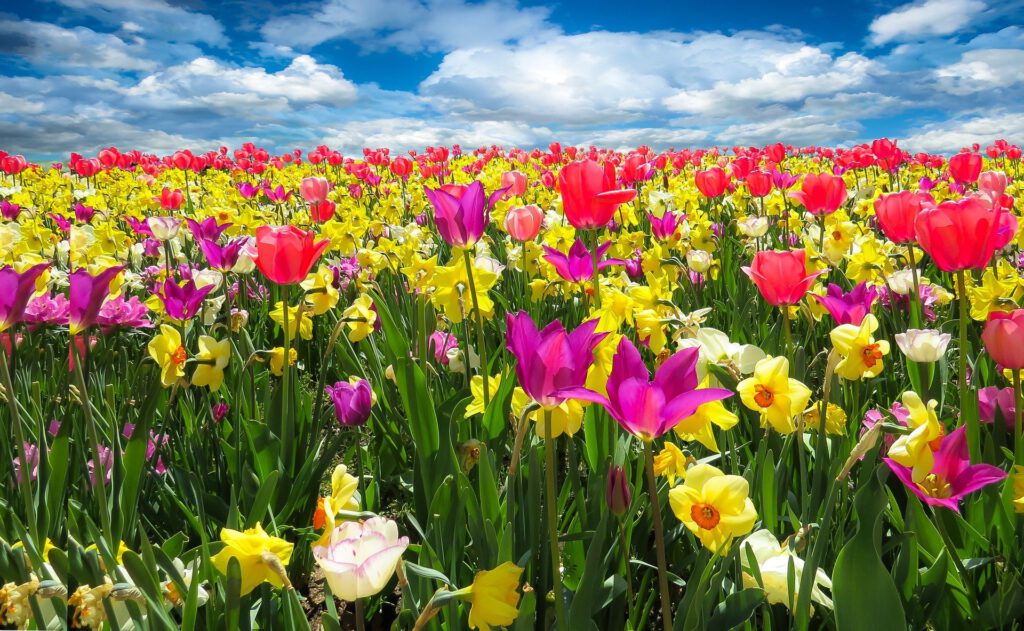
The many tulip fields of the Netherlands are mainly located in the province of Flevoland. It truly is a tulip paradise, and tulips are great for decorative purposes. But this may scare you: tulips did not originate from the Netherlands, but Turkey and central Asia. They were brought to Europe in the 15th century. First to Vienna, and later to the Netherlands. Nowadays, the Netherlands is the biggest flower exporter worldwide.
The most popular flower fields in the Netherlands are the tulip fields. But as the biggest flower export worldwide, the Netherlands has more popular flowers. Other popular flowers grown in the Netherlands, are the lily, daffodil, gladiolus, crocus, and amaryllis. Also, the Netherlands is the European centre for importing African roses. The Dutch flowers are sold to all kinds of European countries. But even in the United States and Chicago, some importers want the Dutch flowers.
The official language of the Netherlands is Dutch. And the Netherlands is not the only country that speaks Dutch. No, even in a part of Belgium, in Suriname, Curaçao, Aruba, and St Maarten is Dutch the official language. And how many people do you think that speak Dutch worldwide? Around 5 million people in the EU speak Dutch as a second language, whereas there are about 23 million native Dutch speakers worldwide! That’s more than you probably expected, huh? It’s colloquially said that Dutch is one of the closest relatives to English and German as well. Maybe that makes it easier for the Dutch to learn English, as most of the Dutch people can speak and understand the English language. The government announced English as the second official language of the Netherlands!
Before we head over and explain all the different provinces in the Netherlands, we will first show you a map so you get an idea of where everything is located. Some maps of the Netherlands show more than the 12 provinces and also a part of the Benelux. Be aware that these are not maps of only the Netherlands. The Benelux is an intergovernmental cooperation of three countries: Belgium, the Netherlands, and Luxemburg. This started during the Second World War, where the governments started to cooperate more closely. When you combine the first two letters of every word, you get Benelux. By the way, if you thought the Netherlands was small: Luxemburg is only a small fraction of the Netherlands!
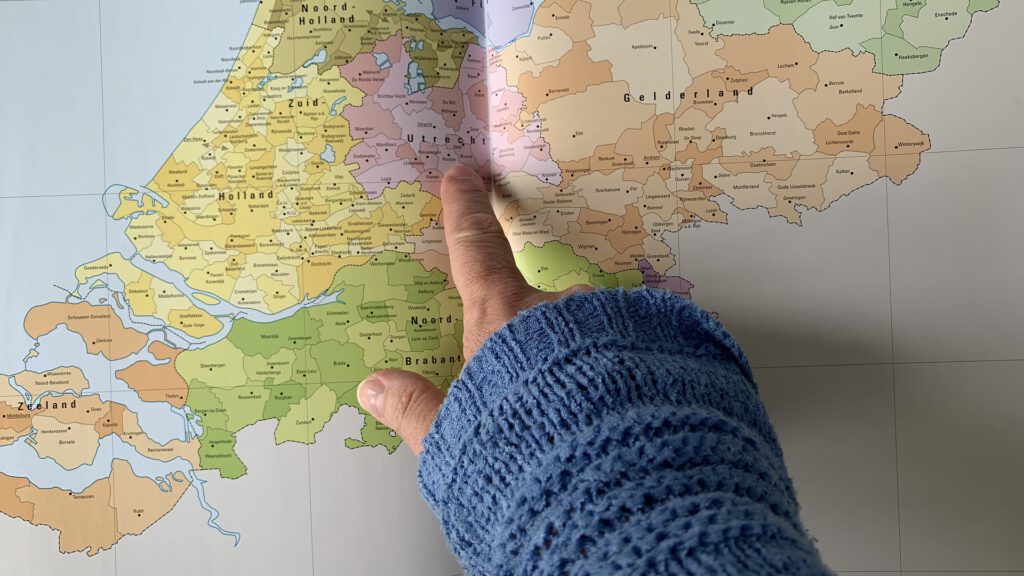
If you are looking for a place where the sun shines more than in the Netherlands, then take a look at our Living in Mallorca – Ultimate guide. In this article, we cover everything you’ll want to know about Mallorca. Beautiful coastal cities, mountain villages, golf courses, Mallorca has everything your heart desires. Therefore, make sure to check out the article and educate yourself in your next summer home.